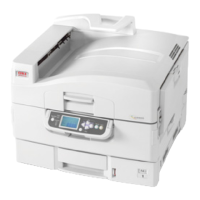1
1-13 Understanding color management systems
Color Reference Guide for C9800 - 13
image data according to a specified source profile and adjusts both RGB and CMYK
data according to a specified output profile, also called a destination profile by some
color management systems.
The source profile defines the RGB color space of the image’s source—characteristics
such as the white point, gamma, and the type of phosphors used. The output profile
defines the gamut of an output device, such as a printer. The Fiery (or the host-based
CMS) uses a device-independent color space to translate between the source color
space and the color space of the output device.
The Fiery allows you to specify default and override settings for the source color space
information and the output profile information (see the Color Guide Chapter 1). When
you use these settings, you do not need to use the features of other color management
systems. Your Fiery software includes ICC profiles for use with other color
management systems, although conflicts may arise when the Fiery CMS is used in
conjunction with a host CMS.
You can also use color management systems to adjust color data to the gamut of an
output device other than the one to which you are printing. This process of simulating
another output device is commonly used for proofing jobs that will be printed on
an offset press. The Fiery simulation feature is described in detail in Chapter 1 of the
Color Guide.
The type of print job and the final output device—Fiery or offset press—determines
the workflow that allows you to achieve the best results. For information about
choosing workflows, see “Using Color Management Workflows” on page 2-16.
Input data Printed data or file
C
o
l
o
r
m
a
n
a
g
e
m
e
n
t
s
y
s
t
e
m
Device-independent
color space
Source
profile
Output
profile

